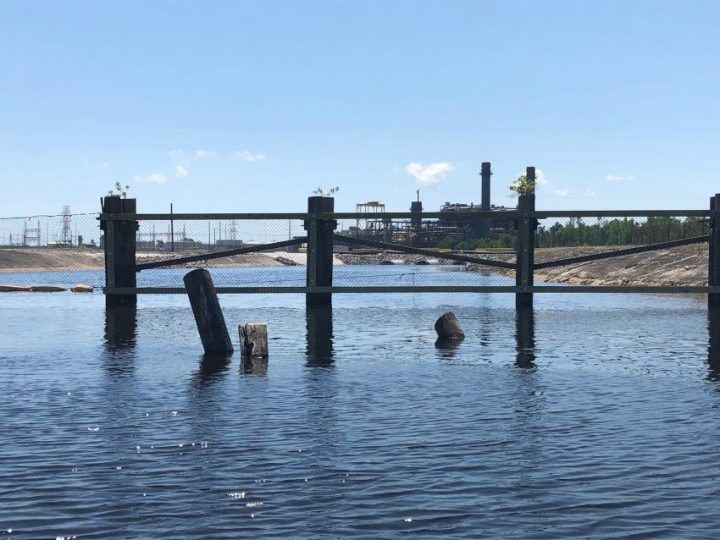
WILMINGTON – Coal ash found in the sediment at the bottom of Lake Sutton suggests multiple, unreported and unmonitored spills have occurred for years at Duke Energy’s former coal-fired plant near Wilmington, according to a new study conducted by researchers at Duke University.
Sediment samples collected from the lake in 2015 and again last year after Hurricane Florence detected contaminants including arsenic, selenium, thalium and copper – metals found in coal.
Supporter Spotlight
“They have similar levels of presence of coal ash solids,” said Duke University’s Avner Vengosh, a professor of geochemistry and water quality who led the research. “Given that we found evidence in the sediments collected from 2015, it’s suggesting it’s not only related to Florence, but it was apparently a long-term process.”
The contamination may have been from floods or other accidental releases as well as past dumping practices, according to the study, Evidence for unmonitored coal ash spills in Sutton Lake, North Carolina: Implications for contamination of lake ecosystems.
Less than a week after Hurricane Florence made landfall Sept. 14, 2018, in Wrightsville Beach, Duke Energy reported that about 2,000 cubic yards of soil and ash – enough to fill about two-thirds of an Olympic-sized swimming pool – spilled from the landfill at L.V. Sutton Power Station.
A little more than a month later, Vengosh and his team conducted a comprehensive sampling of bottom sediments from seven sites in the lake and three sites in the nearby Cape Fear River.
They believed they might find traces of coal ash in the lake, he said.
Supporter Spotlight
“I’m totally surprised because the magnitude of contaminants we’re finding is pure coal ash,” he said. “It is surprising. It was not expected to find that level of contaminants. We thought we might find traces, but not at that level.”
The levels discovered in the lake bottom sediment are similar to or higher than the levels of contaminants found in stream sediments collected after the 2008 Tennessee Valley Authority coal ash spill into the Emory and Clinch rivers, the largest coal ash spill in history, and the 2014 Dan River spill near Eden, in Rockingham County, Vengosh said.
The Lake Sutton sediment samples were compared to sediment bottom collected from Columbus County’s Lake Waccamaw, which is not associated with coal ash disposal.
Duke Energy spokesman Bill Norton said in an email that the results of the study were neither new nor unexpected.
“It is ludicrous to compare decades-old ash at the bottom of a manmade wastewater facility to anything found in conventional lakes and rivers,” he said. “This wastewater facility did exactly what it was designed to do, serve as a buffer between our former coal plant and the Cape Fear river to keep the public and environment safe. We’ve shared similar sediment results going back to the mid-90s with the N.C. Wildlife Resources Commission, so these findings are not at all surprising. Most importantly, the results are not relevant to anyone’s health. We have decades’ worth of surface water tests and fish tests, all shared with regulators, that demonstrate Sutton Lake is well within water quality standards and the Sutton fishery is healthy and thriving.”
“This wastewater facility did exactly what it was designed to do, serve as a buffer between our former coal plant and the Cape Fear river to keep the public and environment safe.”
Bill Norton, Duke Energy
Norton said the company samples water quality and chemistry from the lake every other month, conducts fish testing every three months, and samples sediment annually “among other studies.”
“These studies continue to demonstrate that the waters and fish populations are well-protected and the public remains safe from coal ash impacts,” he said.
River sediment collected downstream from Sutton Lake last October showed “relatively low” metal concentrations compared to those found in the lake, according to the study. Researchers note that further studies need to be conducted to fully evaluate the possible migration of coal ash solids downstream.
The Sutton power station operated as a coal-fired plant for more than 40 years before being shut down in 2013 and converted into a 625-megawatt natural gas plant.
Lake Sutton was formed in 1972 as a cooling source for the former power plant.
Over the years, the 1,100-acre lake has become a popular fishing spot.
The lake’s year-round mild water temperatures make it one of a few places where largemouth bass may be caught throughout the winter.
Sutton Lake, which has been open to the public since it was created, is also popular for recreational boaters.
At least two studies published within the last five years examining selenium in sediment bottom and fish in the lake found selenium in the fish.
Selenium is an element found in coal ash that can cause deformities and impair growth and reproduction in fish and other aquatic life.
Test results from a 2015 Duke University study showed 85 percent of all fish muscle samples examined from Sutton Lake contained selenium levels above the Environmental Protection Agency’s threshold.
Prior to that study, Dennis Lemly, an environmental consultant specializing in ecotoxicology and a former researcher biologist with the U.S. Department of Forest Service, collected in 2013 and assessed juvenile fish from the lake during a five-month period.
His assessment showed that discharges from the plant were causing selenium poisoning in young fish and reducing their chances of survival.
“We have strong evidence that contaminants we are finding in the fish are derived from the coal ash and apparently from the spill of coal ash solids in the bottom of the lake,” Vengosh said.
Norton said that the company’s many years of fish monitoring “indicates a healthy, self-sustaining and balanced fish community.”
“Historical routine documented inspections of the Sutton ash basins demonstrate that, with very brief exceptions during a couple major flooding events, all basins have operated as expected,” he said in the email. “Even during those events, no substantial quantities of ash were released to Sutton Lake.”
According to Duke Energy’s website, ash has been excavated from seven of its basins, including two in North Carolina in Asheville and Mooresboro. About 22 million tons of ash has been excavated since the company began closing basins in recent years, the site states.
Excavation of basins at the company’s Dan River facility in Eden, one in Mount Holly and at the plant near Wilmington will be completed “in the coming months.”
The energy company will stop sending ash and wastewater to “nearly all basins” by mid-year, according to information provided on the website.
“To accomplish this, the company constructed dry bottom ash handling systems, lined water treatment basins and new line retention basins at a number of operating coal plants,” the website states.
Despite the closures, Vengosh warns that the contaminants from coal ash are legacy pollutants, meaning they remain long after they were first introduced in the environment.
“A coal ash spill is not a one-time contamination,” he said in a press release. “It builds up a legacy in the environment. Even if you close the site, the legacy and threat remain, as our research has revealed at Sutton Lake and other coal ash spill sites such as Kingston, Tennessee. Collectively, these finding imply that the distribution and impact of coal ash in the environment is far larger than previously thought.”
If coal ash is in the sediment in Sutton Lake, it stands to reason the same may be true for other cooling ponds and waterways near coal ash basins, he said.
“It’s kind of a bigger question,” Vengosh said. “How much coal ash is being exposed to the environment. What are we going to do about it? Those are pretty big questions that need to be addressed.”
Sen. Harper Peterson and Rep. Deb Butler announced Monday a joint press conference to be held Tuesday morning at Lake Sutton to discuss the study’s findings.








